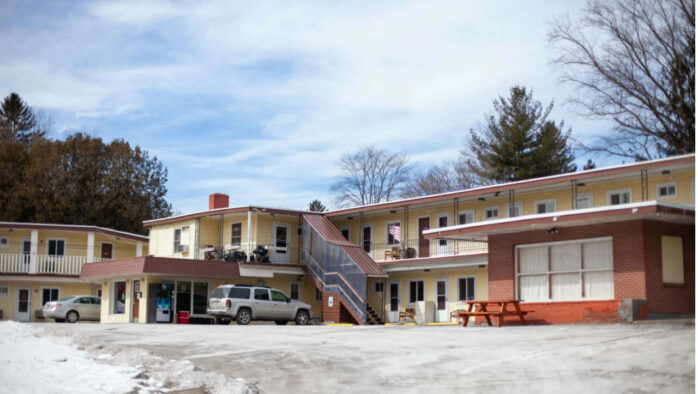
By Mike Dougherty/VTDigger
The Travel Inn in Rutland was one of at least 75 motels in Vermont where state agencies housed people who would otherwise be homeless.
The Dept. for Children and Families (DCF) has announced the successful continuation of sheltering all Vermonters currently in a motel and eligible for the General Assistance (GA) Emergency Housing program. This has been made possible through collaboration with hotels/motels that accepted the new negotiated rate of $80 per night, according to a news release Friday, March 1.
While a handful of hotels/motels opted not to accept the new rate, no Vermonter lost their room due to these negotiations and subsequent new rates. Individuals requiring relocation were moved to alternate hotels/motels within the same geographic area.
During the pandemic, the state simply paid the room rate designated by the hotel/motel for Vermonters housed in the GA hotel/motel program. The negotiated rate is almost half what the hotels/motels had been charging under the GA program.
As part of regular monthly procedures, the DCF Economic Services Division is seeing a natural change (rise and fall) in the population served by the GA Emergency Housing Program based on program guidelines. DCF will continue offering alternative options for Vermonters needing to seek shelter at an alternate location.
“Understanding that this process moved quickly and there was a fair amount of confusion in our communities,” DCF stated in the news release.
The Economic Services Division extended housing center hours through last weekend and VT-211 will continue to operate their after-hours call center each night until 11 p.m. “DCF appreciates everyone’s understanding and cooperation as they work diligently to ensure continued support for Vermonters in need,” the statement continued.
Governor Phil Scott supported the results of the negotiations. He issued the following statement after the announcement March 1: “This room rate cap is an important tool in our work to provide temporary, emergency shelter for our most vulnerable while moving to more permanent solutions. By reducing the cost we’re paying per room, we’ll be better able to fund this program as we work on other more effective solutions to permanently and safely shelter and house those in need.
“It’s important for program participants and Vermonters to understand that we’re continuing to wind down the pandemic-era approach, and there will continue to be changes to eligibility. This includes the annual shift in our Adverse Weather Conditions policy on March 15, which will make this policy weather dependent.
“This is going to continue to be a difficult transition, but we’re working to do it in a way that protects those with the greatest needs. Importantly, the expansion of this emergency housing program in recent years has not been the best approach to meeting the needs of unhoused individuals and the high cost is not sustainable for Vermonters. So, it’s critical for the Legislature to work with us on our proposals to make it less expensive, faster and easier to build housing and shelters. Restoring existing housing stock and creating new units is the only way to truly end homelessness in Vermont.
“I want to thank the team of state employees across multiple agencies who have worked diligently to make sure we could transition to this rate cap on March 1 without losing the capacity to shelter those currently in rooms. Our Buildings and General Services Property Management Director Eric Pembroke led an intensive effort to achieve this goal, supported by Miranda Gray, deputy commissioner at DCF, and I appreciate their – and the full team’s – work. I also want to thank the Legislature for working with us on this rate cap, and for passing it under pressure from advocates who were not supportive.”
For more information visit:
DCF.vermont.gov.




